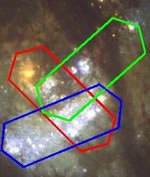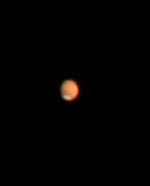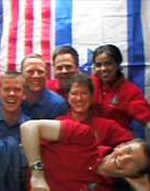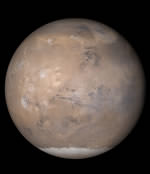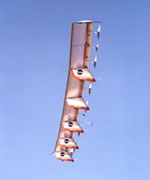
Image credit: NASA
NASA’s remotely piloted Helios aircraft was destroyed on Thursday when it broke up over the Pacific Ocean near the Hawaiian Islands. The Helios is a large flying covered with solar cells which is designed to fly at very high altitudes for very long durations – it broke the world altitude record when it reached 29,500 metres in August, 2001. In the future, fleets of these aircraft could replace the services of satellites for a fraction of the cost. The cause of the accident isn’t known.
The remotely operated Helios Prototype aircraft, a proof-of-concept solar-electric flying wing designed to operate at extremely high altitudes for long duration, was destroyed when it crashed today during a checkout flight from the U.S. Navy?s Pacific Missile Range Facility (PMRF) on the Hawaiian island of Kauai.
There was no property damage or injuries on the ground resulting from the accident. The remotely piloted aircraft came down within the confines of the PMRF test range over the Pacific Ocean west of the facility. Cause of the mishap is not yet known.
The solar-electric, propeller-driven aircraft had been flying under the guidance of ground-based mission controllers for AeroVironment, Inc., of Monrovia, Calif., the plane?s builder and operator. The lightweight flying wing had taken off from PMRF at about 10:06 a.m. on a functional checkout flight and had been aloft for about 29 minutes over the PMRF test range when the mishap occurred. The mishap occurred during a shakedown mission in preparation for a long-endurance mission of almost two days that had been planned for next month.
The Helios Prototype is one of several remotely piloted aircraft whose technological development has been sponsored and funded by NASA under the Environmental Research Aircraft and Sensor Technology (ERAST) program, managed by NASA?s Dryden Flight Research Center, Edwards, Calif. Current to power its electric motors and other systems was generated by high-efficiency solar cells spread across the upper surface of its 247-foot long wing during the day and by an experimental fuel cell-based electrical system at night. The Helios Prototype was designed to fly at altitudes of up to 100,000 feet on single-day atmospheric science and imaging missions, as well as perform multi-day telecommunications relay missions at altitudes of 50,000 to 65,000 feet.
The Helios Prototype set a world altitude record for winged aircraft of 96,863 feet during a flight from the Navy facility at Barking Sands, Kauai, in August 2001.
An accident investigation team will be formed by NASA and supported by AeroVironment and the U.S. Navy to determine the exact cause of the Helios Prototype mishap.
Original Source: NASA News Release

